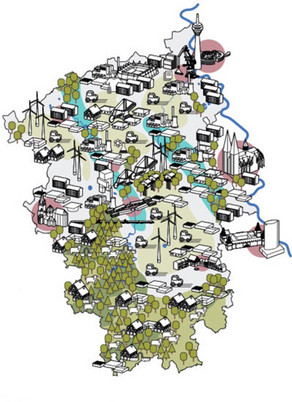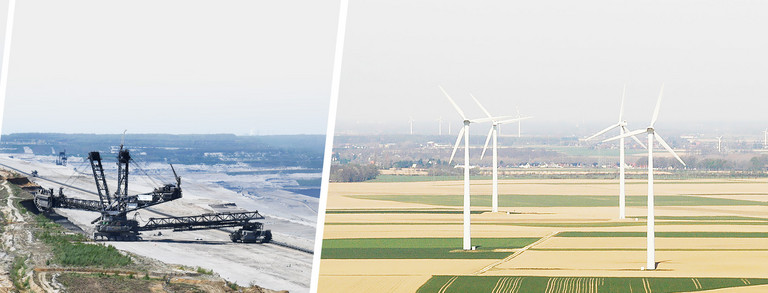Project structure
DAZWISCHEN is divided into five content-related and two organizational work packages (WP).
Work packages over the course of the project
Organizational work packages
WP1 "Project management and communication platform" is the central control center of the research project and extends over the entire duration of the project. IRPUD, TU Dortmund University, is responsible for the overall coordination of content and finances. It also maintains contact with the project sponsor and thematically related projects of the "Stadt Land Plus" program. The steering group, consisting of the overall coordinator and the heads of the other WPs, coordinates the work of the individual partners. A project advisory board, made up of representatives from civil society, (planning) practice in the Rhenish mining district and comparable regions, advises DAZWISCHEN on solutions, results and their implementation.
WP7 "Evaluation/knowledge transfer" is again of an organizational nature, extends over the entire duration of the project and is led by IRPUD, TU Dortmund University.
An evaluation matrix will be created for the evaluation, which relates the project goals to the UN sustainability goals. In addition, the evaluation concept consists of the four components "semi-annual reflection meetings with the project participants", "continuous stakeholder monitoring", "participation evaluation after events" and "evaluation of the DAZWISCHEN impact indicators via ex-ante/ex-post surveys of key stakeholders".
The aim of knowledge transfer is to make the project results usable for research and practice. To this end, a series of events will be held, e.g. a kick-off forum to raise awareness of DAZWISCHEN, an interim and final conference to present the results or a workshop with project representatives from other structural change regions to ensure transferability. For scientific exploitation, 10 publications in peer-reviewed journals, the implementation of student projects (TU Dortmund) and urban planning designs (RWTH Aachen), as well as 25 final theses each on the topic and space of DAZWISCHEN at the TU and RWTH are planned.
Content work packages
In order to utilize the existing regional and local knowledge for DAZWISCHEN and to make the research results practically usable for the region, the format of real-world laboratories is used. Their conception and implementation is assigned to WP2 "Networking and participation (real-world laboratories)", which is coordinated by RWTH Aachen University. In the first six months, participants will be recruited for three real-world laboratories at the levels of "Rheinisches Revier/Gesamtregion", "Kreis Euskirchen" and "Stadt Düren". The network of stakeholders of the Zukunftsagentur Rheinisches Revier (ZRR) will be used for this purpose.
The selection of participants should cover as many relevant specialist areas and (administrative) levels as possible (interdisciplinary and multi-hierarchical). In each of the three real-world laboratories, the focus is on a different group of stakeholders: At the level of the overall region, all member municipalities of the ZRR as well as regional stakeholders such as the regional planning authorities of Cologne and Düsseldorf, RWE or the Zweckverband Region Aachen are to be involved. The "Kreis Euskirchen" real-world laboratory is aimed at the municipalities and institutions based there, such as business development and nature conservation associations. The general public will then be addressed at the level of the city of Düren.
During the remainder of the project, the real-world laboratories will be filled with content by the other WPs and carried out in suitable formats (workshops, citizens' workshops, future workshops).
The aim of WP3, led by IRPUD, TU Dortmund University, is the "identification of central structural changes and their effects" in the Rhenish mining area for the fields of action "climate", "open space", "settlement area", "mobility and transport" and "services of general interest". The "parallel modeling" approach is used, which only uses current data for the description and analysis of the current spatial status and only draws on projections for the description of future developments.
In the first eight months of the project, the current spatial status and its land uses are described. The basis for this is a collection of data from suitable official statistics, which is enriched with microgeographical statistics from other sources. In addition, data available from various planning authorities, e.g. regional planning or municipal urban land-use planning, is pooled. These are processed and compiled in the "Diagnosis I" workshop series with the partners and external experts. The results are then presented in analysis and thesis maps.
By project month 18, the projections of structural developments will be made on this basis. This is done in the time steps "near future" (up to 2040) and "distant future" (2040-2080). While data for GIS-based, quantitative modeling is still available in the near future, e.g. population forecasts, statements from spatial planning plans, this is not the case in the distant future. The "Scenario I" series of workshops will therefore provide a qualitative assessment of trends for the distant future. Both the projections for the near and distant future are subject to uncertainties, which is why the developments can only be presented as a "possibility space"/scenario corridor within which various "futures" are possible.
The results of WP3 are used in WP4 for the development of mission statements and strategies (projections), in WP5 for the creation of the spatial information system (RIS) (current data and projections) and in WP6 for the derivation of action strategies (current data).
The aim of WP4 "Dialogue and mission statement process", led by RWTH Aachen University, is to draw up a development strategy/mission statement for the Rhenish mining district. Initially, development profiles will be drawn up in the project months 15-19 for the three sub-regions of the Rhenish mining district, the district of Euskirchen and the city of Düren, which will show the opportunities and talents as well as possible development paths of the sub-regions. This will be done in the "Diagnosis II" series of workshops, which will once again involve stakeholders from all disciplines and spatial levels. The results are reviewed by the advisory board and the sub-area profiles are then compiled into an overall spatial representation.
Together with the spatial development strategies of the ZRR, these form the basis for the development of guiding principles in the project months 19-24. First, the expectations of the stakeholders at the three levels of observation are collected with the help of the "Scenario II" workshop series and guidelines for spatial development are defined. Next, the projected developments (WP3.2) are compared with the expectations of the stakeholders in order to improve the knowledge and decision-making basis (backcasting approach). This forms the basis for the final development of the regional development concept / mission statement with all stakeholders.
WP5 aims to "develop and implement a multi-hierarchical spatial information system (RIS)" and is managed by the Infas Institute for Applied Social Science. The RIS is intended to provide the spatial planners of the Rhenish mining district with a basis for decision-making in their practical work, e.g. by enabling the continuous monitoring of significant environmental impacts within the meaning of Section 28 UVPG or Section 4c-BauGB and, in the best case, represent a prototype for transfer to other regions.
The results of WP3 form the most comprehensive data basis possible for the RIS. Furthermore, attention should be paid to a modular, multi-hierarchical structure of the system, which, against the background of the lack of uniform administrative boundaries, allows a holistic view of the Rhenish mining area. In addition to the map output function and the ability to carry out their own analyses such as area calculations, potential users of the RIS should be given write access so that they can update the data even after the project has ended. The beta version created with these parameters in project months 15-36 is to be finalized within the remaining project duration. The system will be tested by means of a simulation game at each of the three study levels (overall region, district of Euskirchen, city of Düren) and a workshop with the potential users in which rules for the structural and procedural organization will be defined. The results are fed into the RIS and the final version is presented to the users in a training session.
WP6 "Development and implementation of sub-regional action strategies" is led by the practice partners Kreis Euskirchen and the city of Düren, which also form the action area of this WP. In project months 25-36, the action strategies are developed with the overarching goal of reducing land use competition between settlement and open space. First, the action areas of the WP and their action requirements are identified based on the results of the mission statement process (WP4). The action strategies are based on existing (informal) plans such as the master plan for the city center in Düren or the demographic action plan for the district of Euskirchen. The action strategies are subsequently developed from these, with the participation of the public, in future workshops. These deal in particular with the topics of housing, economic development, open space, tourism and the upgrading of rural areas. In subsequent workshops, projects for the implementation of the action strategies are designed and specified, including the necessary funding.
The projects are implemented in the project months 37-60, which is accompanied by a transfer of the results into planning practice, e.g. the redrafting of Düren's land use plan. A further aim is to shift the funding management and application priorities towards sustainable land management.


